Aged Care: Rehabilitation Nursing for Falls and Hip Replacement
VerifiedAdded on 2023/04/23
|13
|3843
|396
Report
AI Summary
This report provides a detailed overview of gerontological aged care rehabilitation nursing for geriatric patients who have suffered a fall and undergone hip replacement surgery. It begins with an account of the pathophysiology of hip fractures, discussing factors such as osteoporosis, mineralization deficits, and the types of fractures (femoral neck and intertrochanteric). The report then delves into comprehensive management plans, emphasizing the importance of a multidisciplinary rehabilitation team consisting of physicians, therapists, and social workers. Key components of the rehabilitation program include early mobilization, fall assessment, kinesiotherapy, physiotherapy, nutritional assessment, and occupational therapy. Finally, the report critically evaluates these management plans, considering indicators like length of stay, pain intensity, mortality rates, infection rates, and adverse events, while also comparing the effectiveness of rehabilitation programs versus home-based care and assessing the role of fall risk assessments and nutritional screening in improving patient outcomes. The study also highlights the importance of early rehabilitation programs in bringing a better outcome in the elderly patients.

Running head: AGED CARE
AGED CARE
Name of the Student
Name of University
Author’s note
AGED CARE
Name of the Student
Name of University
Author’s note
Paraphrase This Document
Need a fresh take? Get an instant paraphrase of this document with our AI Paraphraser

1
AGED CARE
Introduction
Falls in the elderly people are a current health care problem. Falls increases the risk of
hospitalization. Hip fracture due to falls is a serious complication for the elderly patients. Falls
might occur at home and also in hospitals. It is a serious event with a 30 day mortality of 11.8 %
and a 1 year mortality of about 40 %. In most of the cases a hip fracture might require a hip
replacement surgery (Radosavljevic et al., 2013). Hip replacement surgery might require
rehabilitation in order to train or prepare the patient to cope up with the normal pace of life such
as self-care activities, to rule out the chance of any post-operative infections, as the patient will
be always under the supervision of the registered caregivers.
The written assignment will provide insight to gerontological aged care rehabilitation
nursing of the geriatric patients who had suffered from a fall and had undergone a hip
replacement surgery. The paper would initially give an account of the pathophysiology of the
health issue supported by current evidences followed by a comprehensive management plan and
the evaluation of the management plans.
Pathophysiology
Hip fractures can be due to a large number of reasons. According to Guerado et al.,
(2016) osteoporosis causes the bones to become weaker making them more vulnerable to
fractures. In New Zealand , as estimated 10 million people suffers from osteoporosis and hip
fracture can occur due to simple weight bearing activities. Elderly women lose bone density
faster than that of men due to the decrease in the estrogen levels. According to Guerado et al.,
AGED CARE
Introduction
Falls in the elderly people are a current health care problem. Falls increases the risk of
hospitalization. Hip fracture due to falls is a serious complication for the elderly patients. Falls
might occur at home and also in hospitals. It is a serious event with a 30 day mortality of 11.8 %
and a 1 year mortality of about 40 %. In most of the cases a hip fracture might require a hip
replacement surgery (Radosavljevic et al., 2013). Hip replacement surgery might require
rehabilitation in order to train or prepare the patient to cope up with the normal pace of life such
as self-care activities, to rule out the chance of any post-operative infections, as the patient will
be always under the supervision of the registered caregivers.
The written assignment will provide insight to gerontological aged care rehabilitation
nursing of the geriatric patients who had suffered from a fall and had undergone a hip
replacement surgery. The paper would initially give an account of the pathophysiology of the
health issue supported by current evidences followed by a comprehensive management plan and
the evaluation of the management plans.
Pathophysiology
Hip fractures can be due to a large number of reasons. According to Guerado et al.,
(2016) osteoporosis causes the bones to become weaker making them more vulnerable to
fractures. In New Zealand , as estimated 10 million people suffers from osteoporosis and hip
fracture can occur due to simple weight bearing activities. Elderly women lose bone density
faster than that of men due to the decrease in the estrogen levels. According to Guerado et al.,

2
AGED CARE
(2016), mineralization deficit is a cause of the “bone weakness’ making the elderly people
susceptible to osteoporotic hip fractures. But as per the recent studies, the problem of
mineralization is that mainly the irregular distribution of the mineralization. The mineral density
of the tissues are significantly higher in the periosteal and decreases from there to the endostium
(Laurent et al., 2013). The alteration in the bone elasticity is due to the tissue variation in the
axial direction of the femoral neck. Again an increased mineral content of the bone tissue with
high porosity has been determined to have a deleterious effect on the bone strength and the risk
of fracture. Poor nutrition at the child hood might also lead to osteoporosis. Taking more
psychoactive medications at the time falls might cause problems in the maintenance of gait in
elderly patients. There are two main types of hip fractures – the femoral neck fracture and the
intertrochanteric region fracture (Rogmark&Leonardsson, 2016).
In a total hip replacement surgery, the damaged bone or the painful joint is removed and
is replaced with the prosthetic parts. The damaged head of the femur is removed and is replaced
with a metal stem that is being placed in the hollow femoral center. The femoral center is then
cemented in to the bone. The metallic ball is then placed on the upper part of the stem and the
ball replaces the removed femoral head (Laurent et al., 2013). The success of the surgery
depends on how the rehabilitation of the patient takes place. The patient might have stitches and
staples running around the wound. It is necessary to avoid getting the wound infected. Again a
good diet promotes proper healing of the tissues with a restoration of the muscle strength. A
graduated walking program should be established in order to increase the mobility slowly
(Rogmark&Leonardsson, 2016). Furthermore there are some complications such as infections,
blood clots, leg length inequality, dislocation, loosening of the implant. These are conditions
which cannot be taken care of properly at home hence a rehabilitation care is necessary for the
AGED CARE
(2016), mineralization deficit is a cause of the “bone weakness’ making the elderly people
susceptible to osteoporotic hip fractures. But as per the recent studies, the problem of
mineralization is that mainly the irregular distribution of the mineralization. The mineral density
of the tissues are significantly higher in the periosteal and decreases from there to the endostium
(Laurent et al., 2013). The alteration in the bone elasticity is due to the tissue variation in the
axial direction of the femoral neck. Again an increased mineral content of the bone tissue with
high porosity has been determined to have a deleterious effect on the bone strength and the risk
of fracture. Poor nutrition at the child hood might also lead to osteoporosis. Taking more
psychoactive medications at the time falls might cause problems in the maintenance of gait in
elderly patients. There are two main types of hip fractures – the femoral neck fracture and the
intertrochanteric region fracture (Rogmark&Leonardsson, 2016).
In a total hip replacement surgery, the damaged bone or the painful joint is removed and
is replaced with the prosthetic parts. The damaged head of the femur is removed and is replaced
with a metal stem that is being placed in the hollow femoral center. The femoral center is then
cemented in to the bone. The metallic ball is then placed on the upper part of the stem and the
ball replaces the removed femoral head (Laurent et al., 2013). The success of the surgery
depends on how the rehabilitation of the patient takes place. The patient might have stitches and
staples running around the wound. It is necessary to avoid getting the wound infected. Again a
good diet promotes proper healing of the tissues with a restoration of the muscle strength. A
graduated walking program should be established in order to increase the mobility slowly
(Rogmark&Leonardsson, 2016). Furthermore there are some complications such as infections,
blood clots, leg length inequality, dislocation, loosening of the implant. These are conditions
which cannot be taken care of properly at home hence a rehabilitation care is necessary for the
⊘ This is a preview!⊘
Do you want full access?
Subscribe today to unlock all pages.

Trusted by 1+ million students worldwide
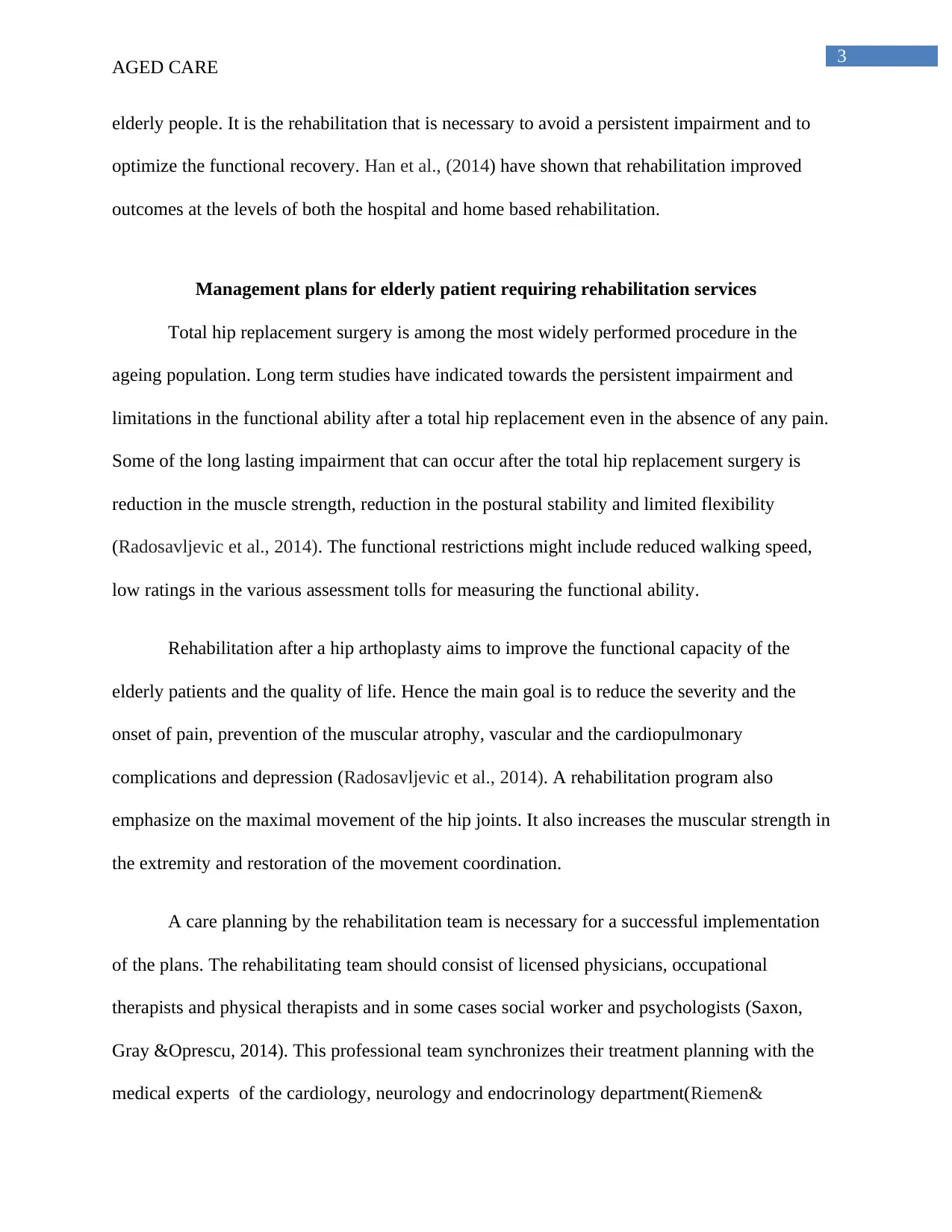
3
AGED CARE
elderly people. It is the rehabilitation that is necessary to avoid a persistent impairment and to
optimize the functional recovery. Han et al., (2014) have shown that rehabilitation improved
outcomes at the levels of both the hospital and home based rehabilitation.
Management plans for elderly patient requiring rehabilitation services
Total hip replacement surgery is among the most widely performed procedure in the
ageing population. Long term studies have indicated towards the persistent impairment and
limitations in the functional ability after a total hip replacement even in the absence of any pain.
Some of the long lasting impairment that can occur after the total hip replacement surgery is
reduction in the muscle strength, reduction in the postural stability and limited flexibility
(Radosavljevic et al., 2014). The functional restrictions might include reduced walking speed,
low ratings in the various assessment tolls for measuring the functional ability.
Rehabilitation after a hip arthoplasty aims to improve the functional capacity of the
elderly patients and the quality of life. Hence the main goal is to reduce the severity and the
onset of pain, prevention of the muscular atrophy, vascular and the cardiopulmonary
complications and depression (Radosavljevic et al., 2014). A rehabilitation program also
emphasize on the maximal movement of the hip joints. It also increases the muscular strength in
the extremity and restoration of the movement coordination.
A care planning by the rehabilitation team is necessary for a successful implementation
of the plans. The rehabilitating team should consist of licensed physicians, occupational
therapists and physical therapists and in some cases social worker and psychologists (Saxon,
Gray &Oprescu, 2014). This professional team synchronizes their treatment planning with the
medical experts of the cardiology, neurology and endocrinology department(Riemen&
AGED CARE
elderly people. It is the rehabilitation that is necessary to avoid a persistent impairment and to
optimize the functional recovery. Han et al., (2014) have shown that rehabilitation improved
outcomes at the levels of both the hospital and home based rehabilitation.
Management plans for elderly patient requiring rehabilitation services
Total hip replacement surgery is among the most widely performed procedure in the
ageing population. Long term studies have indicated towards the persistent impairment and
limitations in the functional ability after a total hip replacement even in the absence of any pain.
Some of the long lasting impairment that can occur after the total hip replacement surgery is
reduction in the muscle strength, reduction in the postural stability and limited flexibility
(Radosavljevic et al., 2014). The functional restrictions might include reduced walking speed,
low ratings in the various assessment tolls for measuring the functional ability.
Rehabilitation after a hip arthoplasty aims to improve the functional capacity of the
elderly patients and the quality of life. Hence the main goal is to reduce the severity and the
onset of pain, prevention of the muscular atrophy, vascular and the cardiopulmonary
complications and depression (Radosavljevic et al., 2014). A rehabilitation program also
emphasize on the maximal movement of the hip joints. It also increases the muscular strength in
the extremity and restoration of the movement coordination.
A care planning by the rehabilitation team is necessary for a successful implementation
of the plans. The rehabilitating team should consist of licensed physicians, occupational
therapists and physical therapists and in some cases social worker and psychologists (Saxon,
Gray &Oprescu, 2014). This professional team synchronizes their treatment planning with the
medical experts of the cardiology, neurology and endocrinology department(Riemen&
Paraphrase This Document
Need a fresh take? Get an instant paraphrase of this document with our AI Paraphraser
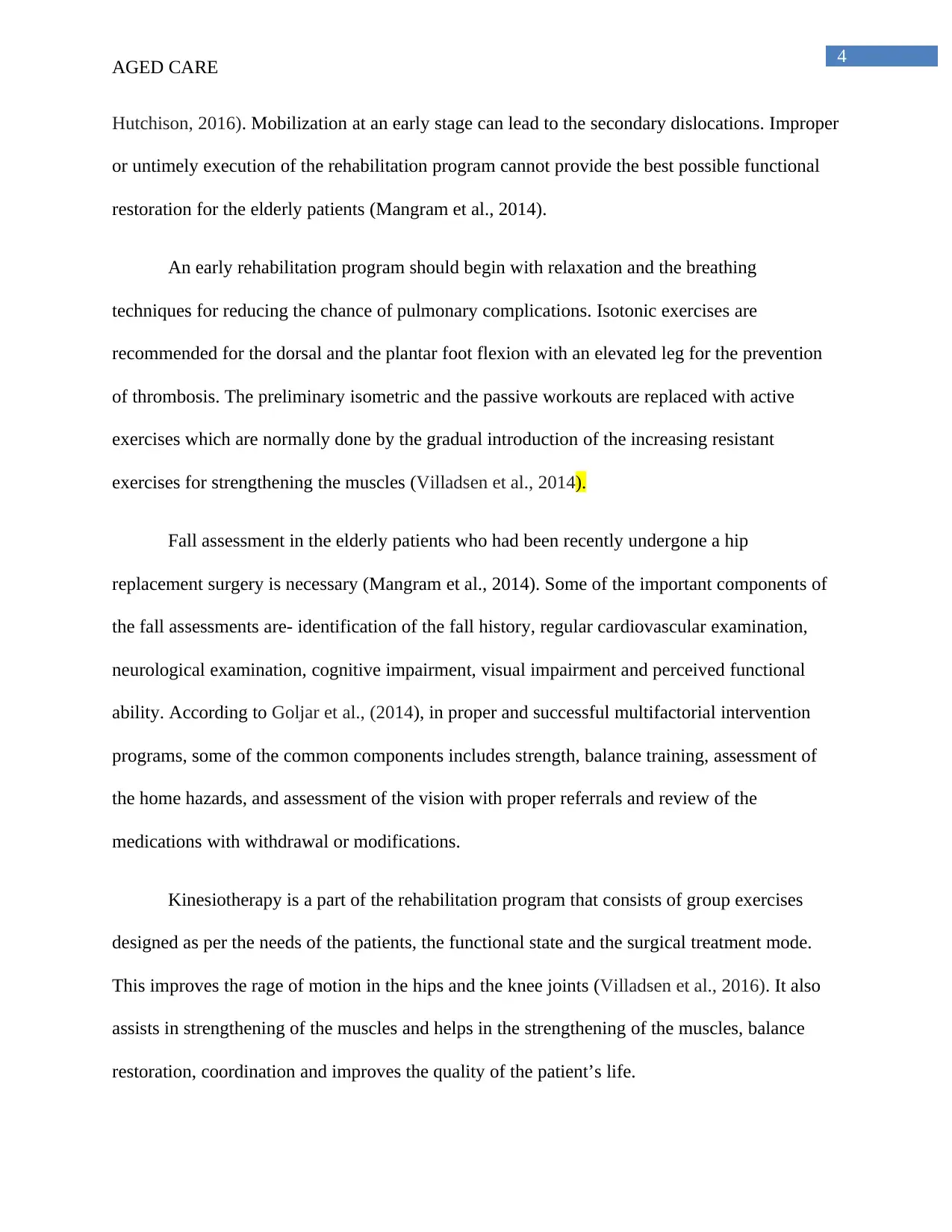
4
AGED CARE
Hutchison, 2016). Mobilization at an early stage can lead to the secondary dislocations. Improper
or untimely execution of the rehabilitation program cannot provide the best possible functional
restoration for the elderly patients (Mangram et al., 2014).
An early rehabilitation program should begin with relaxation and the breathing
techniques for reducing the chance of pulmonary complications. Isotonic exercises are
recommended for the dorsal and the plantar foot flexion with an elevated leg for the prevention
of thrombosis. The preliminary isometric and the passive workouts are replaced with active
exercises which are normally done by the gradual introduction of the increasing resistant
exercises for strengthening the muscles (Villadsen et al., 2014).
Fall assessment in the elderly patients who had been recently undergone a hip
replacement surgery is necessary (Mangram et al., 2014). Some of the important components of
the fall assessments are- identification of the fall history, regular cardiovascular examination,
neurological examination, cognitive impairment, visual impairment and perceived functional
ability. According to Goljar et al., (2014), in proper and successful multifactorial intervention
programs, some of the common components includes strength, balance training, assessment of
the home hazards, and assessment of the vision with proper referrals and review of the
medications with withdrawal or modifications.
Kinesiotherapy is a part of the rehabilitation program that consists of group exercises
designed as per the needs of the patients, the functional state and the surgical treatment mode.
This improves the rage of motion in the hips and the knee joints (Villadsen et al., 2016). It also
assists in strengthening of the muscles and helps in the strengthening of the muscles, balance
restoration, coordination and improves the quality of the patient’s life.
AGED CARE
Hutchison, 2016). Mobilization at an early stage can lead to the secondary dislocations. Improper
or untimely execution of the rehabilitation program cannot provide the best possible functional
restoration for the elderly patients (Mangram et al., 2014).
An early rehabilitation program should begin with relaxation and the breathing
techniques for reducing the chance of pulmonary complications. Isotonic exercises are
recommended for the dorsal and the plantar foot flexion with an elevated leg for the prevention
of thrombosis. The preliminary isometric and the passive workouts are replaced with active
exercises which are normally done by the gradual introduction of the increasing resistant
exercises for strengthening the muscles (Villadsen et al., 2014).
Fall assessment in the elderly patients who had been recently undergone a hip
replacement surgery is necessary (Mangram et al., 2014). Some of the important components of
the fall assessments are- identification of the fall history, regular cardiovascular examination,
neurological examination, cognitive impairment, visual impairment and perceived functional
ability. According to Goljar et al., (2014), in proper and successful multifactorial intervention
programs, some of the common components includes strength, balance training, assessment of
the home hazards, and assessment of the vision with proper referrals and review of the
medications with withdrawal or modifications.
Kinesiotherapy is a part of the rehabilitation program that consists of group exercises
designed as per the needs of the patients, the functional state and the surgical treatment mode.
This improves the rage of motion in the hips and the knee joints (Villadsen et al., 2016). It also
assists in strengthening of the muscles and helps in the strengthening of the muscles, balance
restoration, coordination and improves the quality of the patient’s life.
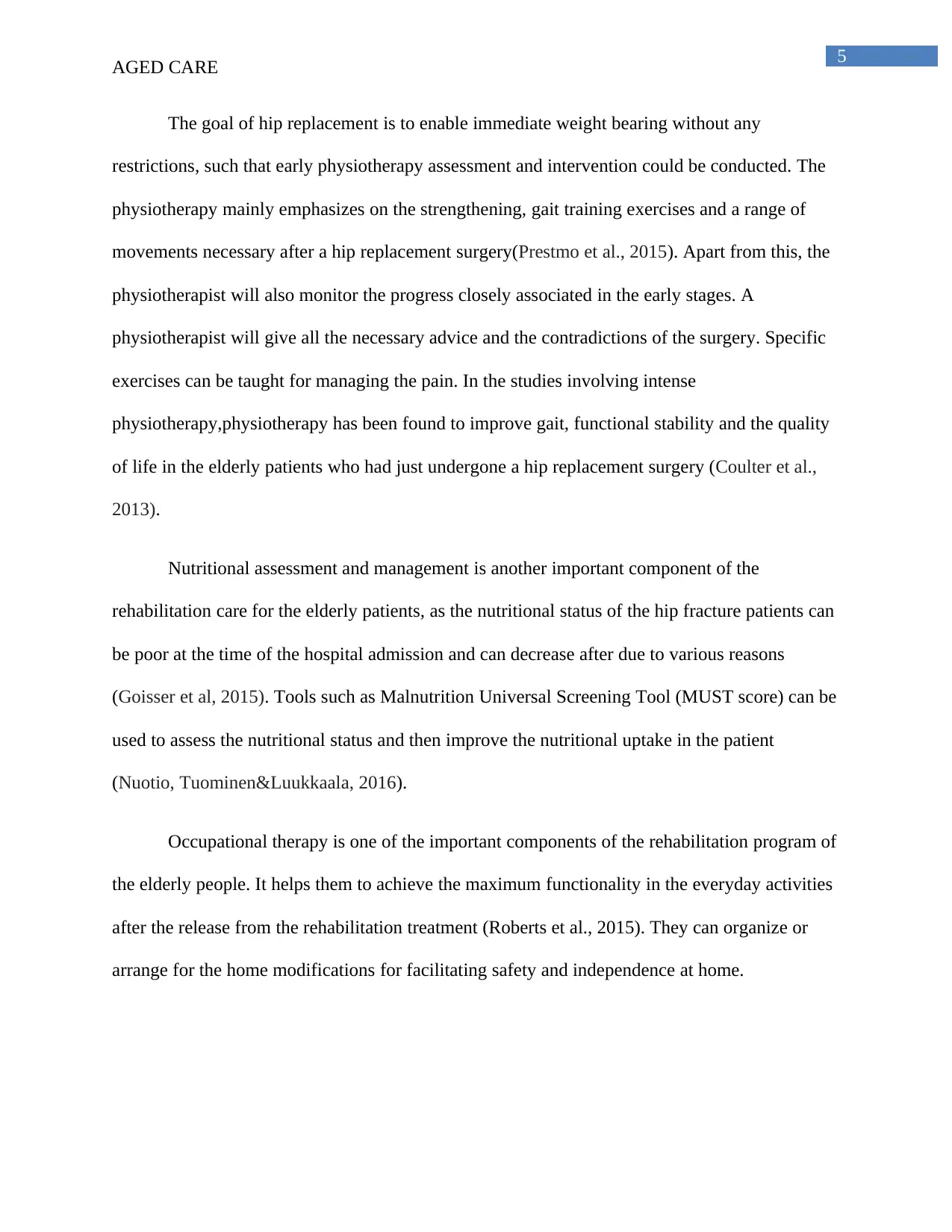
5
AGED CARE
The goal of hip replacement is to enable immediate weight bearing without any
restrictions, such that early physiotherapy assessment and intervention could be conducted. The
physiotherapy mainly emphasizes on the strengthening, gait training exercises and a range of
movements necessary after a hip replacement surgery(Prestmo et al., 2015). Apart from this, the
physiotherapist will also monitor the progress closely associated in the early stages. A
physiotherapist will give all the necessary advice and the contradictions of the surgery. Specific
exercises can be taught for managing the pain. In the studies involving intense
physiotherapy,physiotherapy has been found to improve gait, functional stability and the quality
of life in the elderly patients who had just undergone a hip replacement surgery (Coulter et al.,
2013).
Nutritional assessment and management is another important component of the
rehabilitation care for the elderly patients, as the nutritional status of the hip fracture patients can
be poor at the time of the hospital admission and can decrease after due to various reasons
(Goisser et al, 2015). Tools such as Malnutrition Universal Screening Tool (MUST score) can be
used to assess the nutritional status and then improve the nutritional uptake in the patient
(Nuotio, Tuominen&Luukkaala, 2016).
Occupational therapy is one of the important components of the rehabilitation program of
the elderly people. It helps them to achieve the maximum functionality in the everyday activities
after the release from the rehabilitation treatment (Roberts et al., 2015). They can organize or
arrange for the home modifications for facilitating safety and independence at home.
AGED CARE
The goal of hip replacement is to enable immediate weight bearing without any
restrictions, such that early physiotherapy assessment and intervention could be conducted. The
physiotherapy mainly emphasizes on the strengthening, gait training exercises and a range of
movements necessary after a hip replacement surgery(Prestmo et al., 2015). Apart from this, the
physiotherapist will also monitor the progress closely associated in the early stages. A
physiotherapist will give all the necessary advice and the contradictions of the surgery. Specific
exercises can be taught for managing the pain. In the studies involving intense
physiotherapy,physiotherapy has been found to improve gait, functional stability and the quality
of life in the elderly patients who had just undergone a hip replacement surgery (Coulter et al.,
2013).
Nutritional assessment and management is another important component of the
rehabilitation care for the elderly patients, as the nutritional status of the hip fracture patients can
be poor at the time of the hospital admission and can decrease after due to various reasons
(Goisser et al, 2015). Tools such as Malnutrition Universal Screening Tool (MUST score) can be
used to assess the nutritional status and then improve the nutritional uptake in the patient
(Nuotio, Tuominen&Luukkaala, 2016).
Occupational therapy is one of the important components of the rehabilitation program of
the elderly people. It helps them to achieve the maximum functionality in the everyday activities
after the release from the rehabilitation treatment (Roberts et al., 2015). They can organize or
arrange for the home modifications for facilitating safety and independence at home.
⊘ This is a preview!⊘
Do you want full access?
Subscribe today to unlock all pages.

Trusted by 1+ million students worldwide
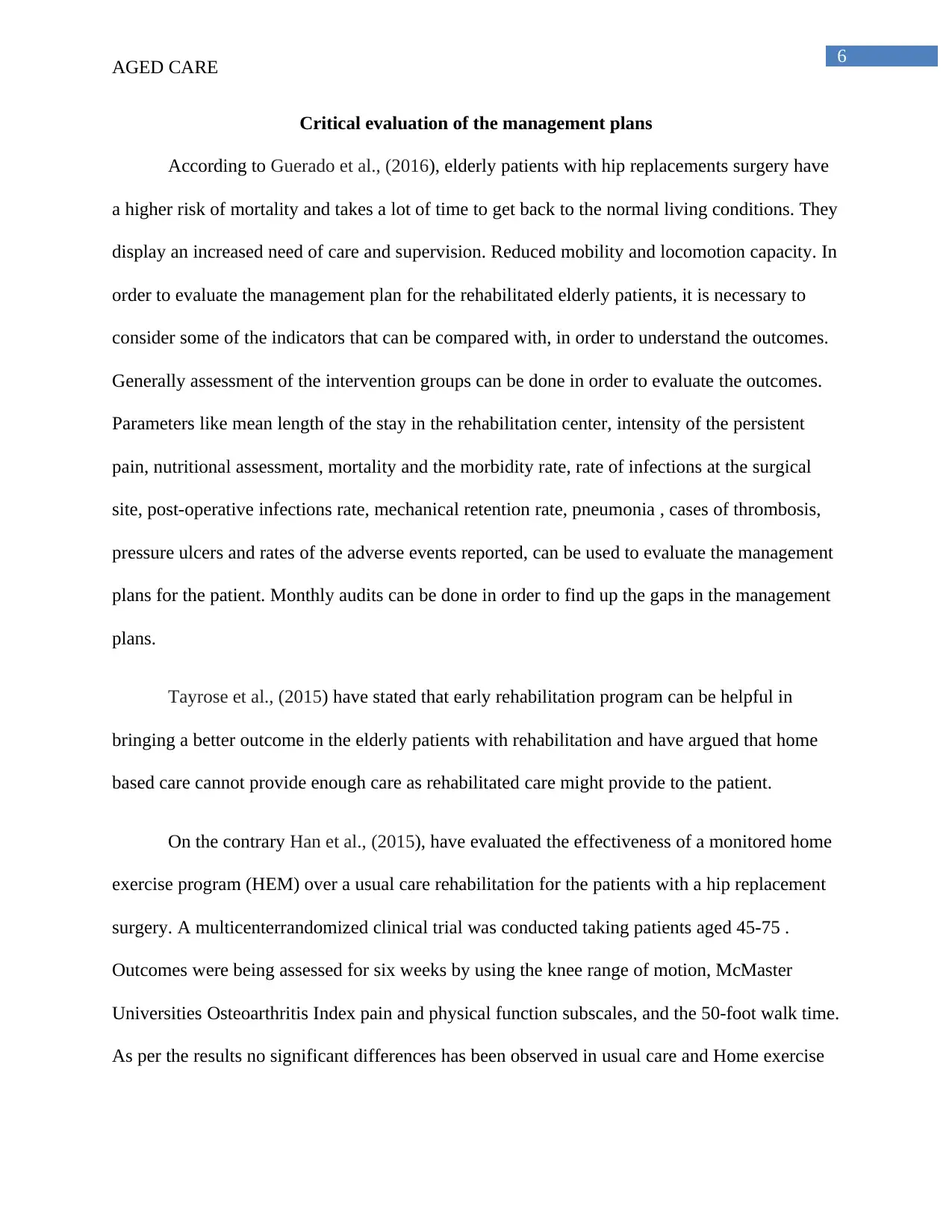
6
AGED CARE
Critical evaluation of the management plans
According to Guerado et al., (2016), elderly patients with hip replacements surgery have
a higher risk of mortality and takes a lot of time to get back to the normal living conditions. They
display an increased need of care and supervision. Reduced mobility and locomotion capacity. In
order to evaluate the management plan for the rehabilitated elderly patients, it is necessary to
consider some of the indicators that can be compared with, in order to understand the outcomes.
Generally assessment of the intervention groups can be done in order to evaluate the outcomes.
Parameters like mean length of the stay in the rehabilitation center, intensity of the persistent
pain, nutritional assessment, mortality and the morbidity rate, rate of infections at the surgical
site, post-operative infections rate, mechanical retention rate, pneumonia , cases of thrombosis,
pressure ulcers and rates of the adverse events reported, can be used to evaluate the management
plans for the patient. Monthly audits can be done in order to find up the gaps in the management
plans.
Tayrose et al., (2015) have stated that early rehabilitation program can be helpful in
bringing a better outcome in the elderly patients with rehabilitation and have argued that home
based care cannot provide enough care as rehabilitated care might provide to the patient.
On the contrary Han et al., (2015), have evaluated the effectiveness of a monitored home
exercise program (HEM) over a usual care rehabilitation for the patients with a hip replacement
surgery. A multicenterrandomized clinical trial was conducted taking patients aged 45-75 .
Outcomes were being assessed for six weeks by using the knee range of motion, McMaster
Universities Osteoarthritis Index pain and physical function subscales, and the 50‐foot walk time.
As per the results no significant differences has been observed in usual care and Home exercise
AGED CARE
Critical evaluation of the management plans
According to Guerado et al., (2016), elderly patients with hip replacements surgery have
a higher risk of mortality and takes a lot of time to get back to the normal living conditions. They
display an increased need of care and supervision. Reduced mobility and locomotion capacity. In
order to evaluate the management plan for the rehabilitated elderly patients, it is necessary to
consider some of the indicators that can be compared with, in order to understand the outcomes.
Generally assessment of the intervention groups can be done in order to evaluate the outcomes.
Parameters like mean length of the stay in the rehabilitation center, intensity of the persistent
pain, nutritional assessment, mortality and the morbidity rate, rate of infections at the surgical
site, post-operative infections rate, mechanical retention rate, pneumonia , cases of thrombosis,
pressure ulcers and rates of the adverse events reported, can be used to evaluate the management
plans for the patient. Monthly audits can be done in order to find up the gaps in the management
plans.
Tayrose et al., (2015) have stated that early rehabilitation program can be helpful in
bringing a better outcome in the elderly patients with rehabilitation and have argued that home
based care cannot provide enough care as rehabilitated care might provide to the patient.
On the contrary Han et al., (2015), have evaluated the effectiveness of a monitored home
exercise program (HEM) over a usual care rehabilitation for the patients with a hip replacement
surgery. A multicenterrandomized clinical trial was conducted taking patients aged 45-75 .
Outcomes were being assessed for six weeks by using the knee range of motion, McMaster
Universities Osteoarthritis Index pain and physical function subscales, and the 50‐foot walk time.
As per the results no significant differences has been observed in usual care and Home exercise
Paraphrase This Document
Need a fresh take? Get an instant paraphrase of this document with our AI Paraphraser
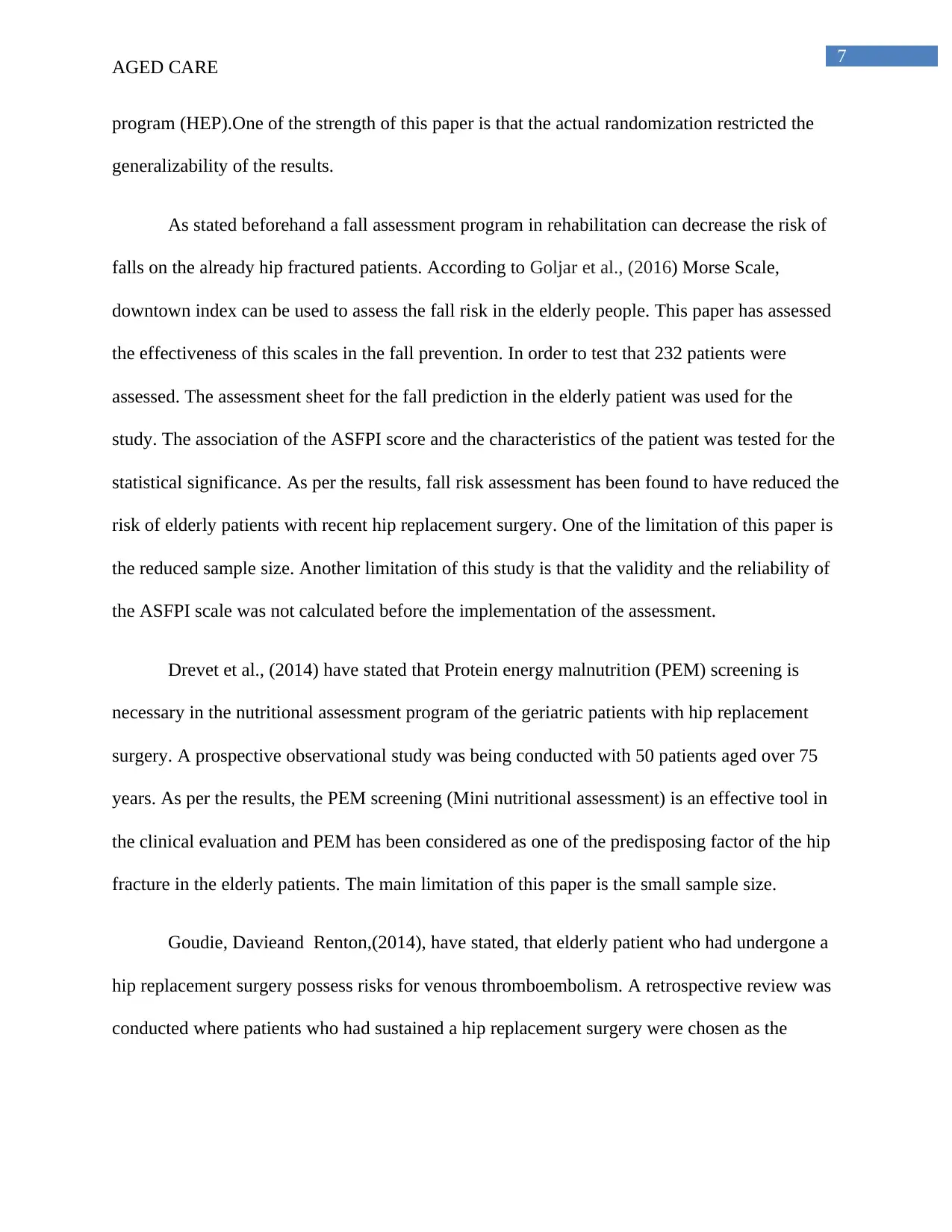
7
AGED CARE
program (HEP).One of the strength of this paper is that the actual randomization restricted the
generalizability of the results.
As stated beforehand a fall assessment program in rehabilitation can decrease the risk of
falls on the already hip fractured patients. According to Goljar et al., (2016) Morse Scale,
downtown index can be used to assess the fall risk in the elderly people. This paper has assessed
the effectiveness of this scales in the fall prevention. In order to test that 232 patients were
assessed. The assessment sheet for the fall prediction in the elderly patient was used for the
study. The association of the ASFPI score and the characteristics of the patient was tested for the
statistical significance. As per the results, fall risk assessment has been found to have reduced the
risk of elderly patients with recent hip replacement surgery. One of the limitation of this paper is
the reduced sample size. Another limitation of this study is that the validity and the reliability of
the ASFPI scale was not calculated before the implementation of the assessment.
Drevet et al., (2014) have stated that Protein energy malnutrition (PEM) screening is
necessary in the nutritional assessment program of the geriatric patients with hip replacement
surgery. A prospective observational study was being conducted with 50 patients aged over 75
years. As per the results, the PEM screening (Mini nutritional assessment) is an effective tool in
the clinical evaluation and PEM has been considered as one of the predisposing factor of the hip
fracture in the elderly patients. The main limitation of this paper is the small sample size.
Goudie, Davieand Renton,(2014), have stated, that elderly patient who had undergone a
hip replacement surgery possess risks for venous thromboembolism. A retrospective review was
conducted where patients who had sustained a hip replacement surgery were chosen as the
AGED CARE
program (HEP).One of the strength of this paper is that the actual randomization restricted the
generalizability of the results.
As stated beforehand a fall assessment program in rehabilitation can decrease the risk of
falls on the already hip fractured patients. According to Goljar et al., (2016) Morse Scale,
downtown index can be used to assess the fall risk in the elderly people. This paper has assessed
the effectiveness of this scales in the fall prevention. In order to test that 232 patients were
assessed. The assessment sheet for the fall prediction in the elderly patient was used for the
study. The association of the ASFPI score and the characteristics of the patient was tested for the
statistical significance. As per the results, fall risk assessment has been found to have reduced the
risk of elderly patients with recent hip replacement surgery. One of the limitation of this paper is
the reduced sample size. Another limitation of this study is that the validity and the reliability of
the ASFPI scale was not calculated before the implementation of the assessment.
Drevet et al., (2014) have stated that Protein energy malnutrition (PEM) screening is
necessary in the nutritional assessment program of the geriatric patients with hip replacement
surgery. A prospective observational study was being conducted with 50 patients aged over 75
years. As per the results, the PEM screening (Mini nutritional assessment) is an effective tool in
the clinical evaluation and PEM has been considered as one of the predisposing factor of the hip
fracture in the elderly patients. The main limitation of this paper is the small sample size.
Goudie, Davieand Renton,(2014), have stated, that elderly patient who had undergone a
hip replacement surgery possess risks for venous thromboembolism. A retrospective review was
conducted where patients who had sustained a hip replacement surgery were chosen as the
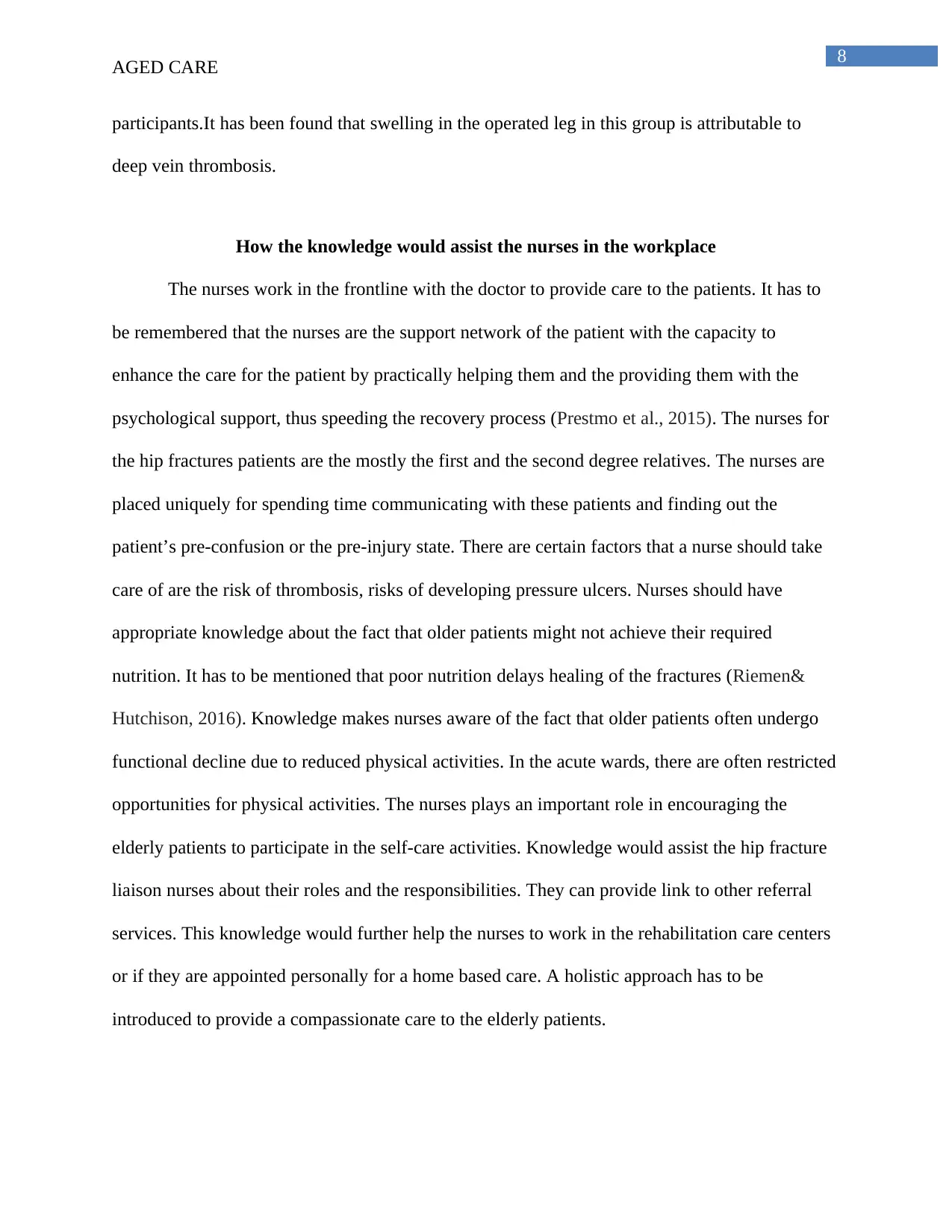
8
AGED CARE
participants.It has been found that swelling in the operated leg in this group is attributable to
deep vein thrombosis.
How the knowledge would assist the nurses in the workplace
The nurses work in the frontline with the doctor to provide care to the patients. It has to
be remembered that the nurses are the support network of the patient with the capacity to
enhance the care for the patient by practically helping them and the providing them with the
psychological support, thus speeding the recovery process (Prestmo et al., 2015). The nurses for
the hip fractures patients are the mostly the first and the second degree relatives. The nurses are
placed uniquely for spending time communicating with these patients and finding out the
patient’s pre-confusion or the pre-injury state. There are certain factors that a nurse should take
care of are the risk of thrombosis, risks of developing pressure ulcers. Nurses should have
appropriate knowledge about the fact that older patients might not achieve their required
nutrition. It has to be mentioned that poor nutrition delays healing of the fractures (Riemen&
Hutchison, 2016). Knowledge makes nurses aware of the fact that older patients often undergo
functional decline due to reduced physical activities. In the acute wards, there are often restricted
opportunities for physical activities. The nurses plays an important role in encouraging the
elderly patients to participate in the self-care activities. Knowledge would assist the hip fracture
liaison nurses about their roles and the responsibilities. They can provide link to other referral
services. This knowledge would further help the nurses to work in the rehabilitation care centers
or if they are appointed personally for a home based care. A holistic approach has to be
introduced to provide a compassionate care to the elderly patients.
AGED CARE
participants.It has been found that swelling in the operated leg in this group is attributable to
deep vein thrombosis.
How the knowledge would assist the nurses in the workplace
The nurses work in the frontline with the doctor to provide care to the patients. It has to
be remembered that the nurses are the support network of the patient with the capacity to
enhance the care for the patient by practically helping them and the providing them with the
psychological support, thus speeding the recovery process (Prestmo et al., 2015). The nurses for
the hip fractures patients are the mostly the first and the second degree relatives. The nurses are
placed uniquely for spending time communicating with these patients and finding out the
patient’s pre-confusion or the pre-injury state. There are certain factors that a nurse should take
care of are the risk of thrombosis, risks of developing pressure ulcers. Nurses should have
appropriate knowledge about the fact that older patients might not achieve their required
nutrition. It has to be mentioned that poor nutrition delays healing of the fractures (Riemen&
Hutchison, 2016). Knowledge makes nurses aware of the fact that older patients often undergo
functional decline due to reduced physical activities. In the acute wards, there are often restricted
opportunities for physical activities. The nurses plays an important role in encouraging the
elderly patients to participate in the self-care activities. Knowledge would assist the hip fracture
liaison nurses about their roles and the responsibilities. They can provide link to other referral
services. This knowledge would further help the nurses to work in the rehabilitation care centers
or if they are appointed personally for a home based care. A holistic approach has to be
introduced to provide a compassionate care to the elderly patients.
⊘ This is a preview!⊘
Do you want full access?
Subscribe today to unlock all pages.

Trusted by 1+ million students worldwide
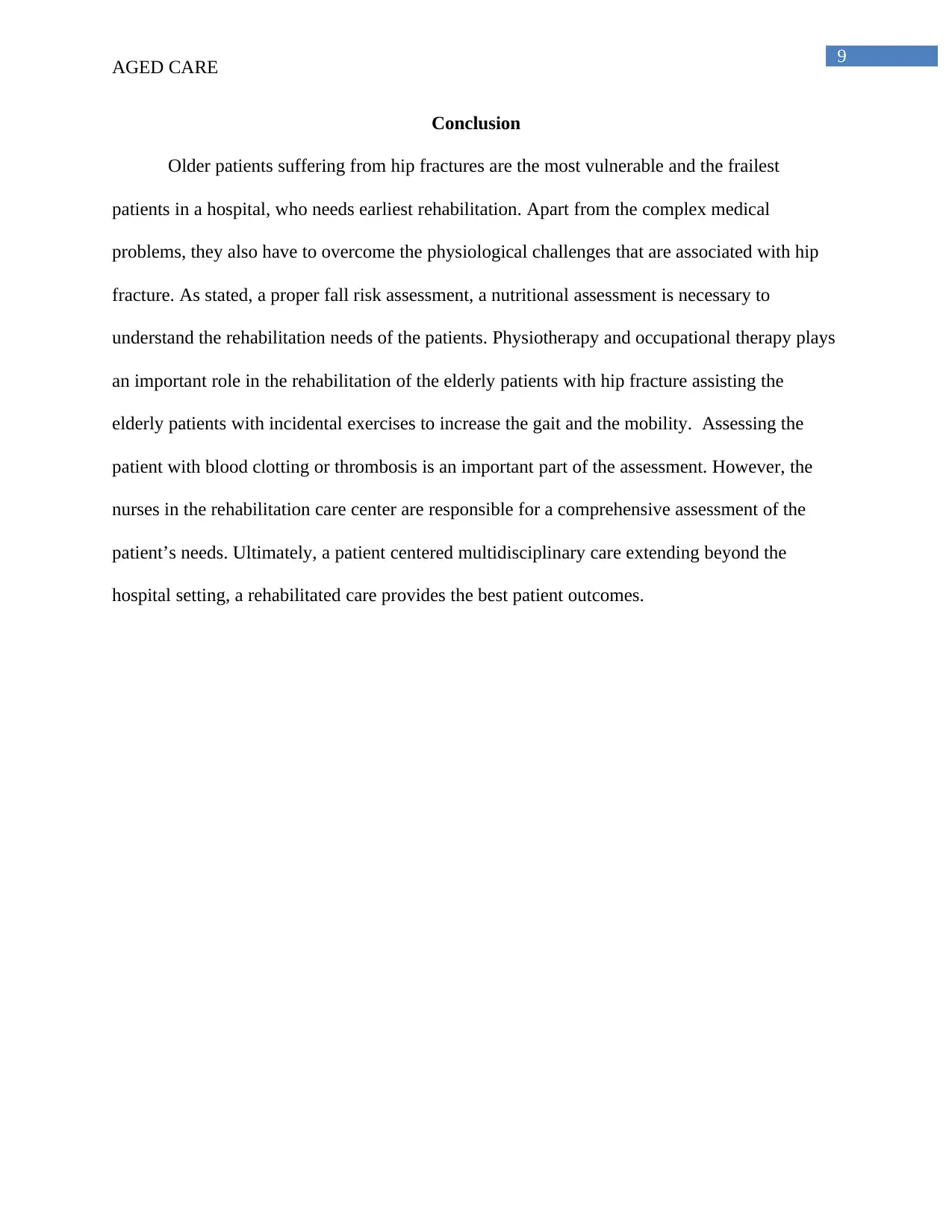
9
AGED CARE
Conclusion
Older patients suffering from hip fractures are the most vulnerable and the frailest
patients in a hospital, who needs earliest rehabilitation. Apart from the complex medical
problems, they also have to overcome the physiological challenges that are associated with hip
fracture. As stated, a proper fall risk assessment, a nutritional assessment is necessary to
understand the rehabilitation needs of the patients. Physiotherapy and occupational therapy plays
an important role in the rehabilitation of the elderly patients with hip fracture assisting the
elderly patients with incidental exercises to increase the gait and the mobility. Assessing the
patient with blood clotting or thrombosis is an important part of the assessment. However, the
nurses in the rehabilitation care center are responsible for a comprehensive assessment of the
patient’s needs. Ultimately, a patient centered multidisciplinary care extending beyond the
hospital setting, a rehabilitated care provides the best patient outcomes.
AGED CARE
Conclusion
Older patients suffering from hip fractures are the most vulnerable and the frailest
patients in a hospital, who needs earliest rehabilitation. Apart from the complex medical
problems, they also have to overcome the physiological challenges that are associated with hip
fracture. As stated, a proper fall risk assessment, a nutritional assessment is necessary to
understand the rehabilitation needs of the patients. Physiotherapy and occupational therapy plays
an important role in the rehabilitation of the elderly patients with hip fracture assisting the
elderly patients with incidental exercises to increase the gait and the mobility. Assessing the
patient with blood clotting or thrombosis is an important part of the assessment. However, the
nurses in the rehabilitation care center are responsible for a comprehensive assessment of the
patient’s needs. Ultimately, a patient centered multidisciplinary care extending beyond the
hospital setting, a rehabilitated care provides the best patient outcomes.
Paraphrase This Document
Need a fresh take? Get an instant paraphrase of this document with our AI Paraphraser

10
AGED CARE
References
Coulter, C. L., Scarvell, J. M., Neeman, T. M., & Smith, P. N. (2013). Physiotherapist-directed
rehabilitation exercises in the outpatient or home setting improve strength, gait speed and
cadence after elective total hip replacement: a systematic review. Journal of
physiotherapy, 59(4), 219-226.
Drevet, S., Bioteau, C., Maziere, S., Couturier, P., Merloz, P., Tonetti, J., &Gavazzi, G. (2014).
Prevalence of protein-energy malnutrition in hospital patients over 75 years of age
admitted for hip fracture. Orthopaedics& Traumatology: Surgery & Research, 100(6),
669-674.
Goisser, S., Schrader, E., Singler, K., Bertsch, T., Gefeller, O., Biber, R., ...&Volkert, D. (2015).
Low postoperative dietary intake is associated with worse functional course in geriatric
patients up to 6 months after hip fracture §. British Journal of Nutrition, 113(12), 1940-
1950.
Goljar, N., Globokar, D., Puzić, N., Kopitar, N., Vrabič, M., Ivanovski, M., &Vidmar, G. (2016).
Effectiveness of a fall-risk reduction programme for inpatient rehabilitation after
stroke. Disability and rehabilitation, 38(18), 1811-1819.
Goudie, C. R., Davie, C., & Renton, J. (2014). 10 ASSESSMENT FOR POSTOPERATIVE
DVT IN OLDER PEOPLE WITH HIP FRACTURES. Age and Ageing, 43(suppl_1), i3-
i3.
AGED CARE
References
Coulter, C. L., Scarvell, J. M., Neeman, T. M., & Smith, P. N. (2013). Physiotherapist-directed
rehabilitation exercises in the outpatient or home setting improve strength, gait speed and
cadence after elective total hip replacement: a systematic review. Journal of
physiotherapy, 59(4), 219-226.
Drevet, S., Bioteau, C., Maziere, S., Couturier, P., Merloz, P., Tonetti, J., &Gavazzi, G. (2014).
Prevalence of protein-energy malnutrition in hospital patients over 75 years of age
admitted for hip fracture. Orthopaedics& Traumatology: Surgery & Research, 100(6),
669-674.
Goisser, S., Schrader, E., Singler, K., Bertsch, T., Gefeller, O., Biber, R., ...&Volkert, D. (2015).
Low postoperative dietary intake is associated with worse functional course in geriatric
patients up to 6 months after hip fracture §. British Journal of Nutrition, 113(12), 1940-
1950.
Goljar, N., Globokar, D., Puzić, N., Kopitar, N., Vrabič, M., Ivanovski, M., &Vidmar, G. (2016).
Effectiveness of a fall-risk reduction programme for inpatient rehabilitation after
stroke. Disability and rehabilitation, 38(18), 1811-1819.
Goudie, C. R., Davie, C., & Renton, J. (2014). 10 ASSESSMENT FOR POSTOPERATIVE
DVT IN OLDER PEOPLE WITH HIP FRACTURES. Age and Ageing, 43(suppl_1), i3-
i3.
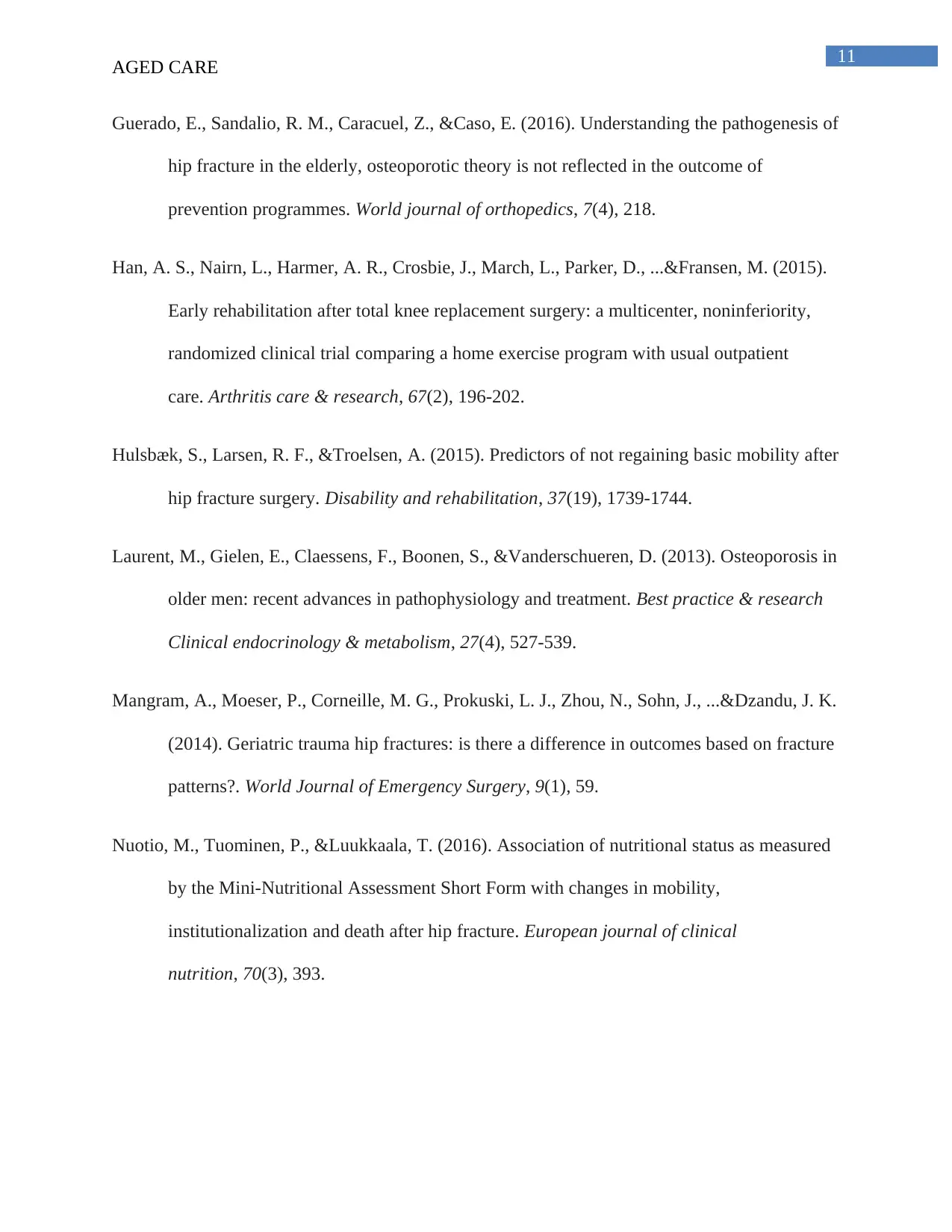
11
AGED CARE
Guerado, E., Sandalio, R. M., Caracuel, Z., &Caso, E. (2016). Understanding the pathogenesis of
hip fracture in the elderly, osteoporotic theory is not reflected in the outcome of
prevention programmes. World journal of orthopedics, 7(4), 218.
Han, A. S., Nairn, L., Harmer, A. R., Crosbie, J., March, L., Parker, D., ...&Fransen, M. (2015).
Early rehabilitation after total knee replacement surgery: a multicenter, noninferiority,
randomized clinical trial comparing a home exercise program with usual outpatient
care. Arthritis care & research, 67(2), 196-202.
Hulsbæk, S., Larsen, R. F., &Troelsen, A. (2015). Predictors of not regaining basic mobility after
hip fracture surgery. Disability and rehabilitation, 37(19), 1739-1744.
Laurent, M., Gielen, E., Claessens, F., Boonen, S., &Vanderschueren, D. (2013). Osteoporosis in
older men: recent advances in pathophysiology and treatment. Best practice & research
Clinical endocrinology & metabolism, 27(4), 527-539.
Mangram, A., Moeser, P., Corneille, M. G., Prokuski, L. J., Zhou, N., Sohn, J., ...&Dzandu, J. K.
(2014). Geriatric trauma hip fractures: is there a difference in outcomes based on fracture
patterns?. World Journal of Emergency Surgery, 9(1), 59.
Nuotio, M., Tuominen, P., &Luukkaala, T. (2016). Association of nutritional status as measured
by the Mini-Nutritional Assessment Short Form with changes in mobility,
institutionalization and death after hip fracture. European journal of clinical
nutrition, 70(3), 393.
AGED CARE
Guerado, E., Sandalio, R. M., Caracuel, Z., &Caso, E. (2016). Understanding the pathogenesis of
hip fracture in the elderly, osteoporotic theory is not reflected in the outcome of
prevention programmes. World journal of orthopedics, 7(4), 218.
Han, A. S., Nairn, L., Harmer, A. R., Crosbie, J., March, L., Parker, D., ...&Fransen, M. (2015).
Early rehabilitation after total knee replacement surgery: a multicenter, noninferiority,
randomized clinical trial comparing a home exercise program with usual outpatient
care. Arthritis care & research, 67(2), 196-202.
Hulsbæk, S., Larsen, R. F., &Troelsen, A. (2015). Predictors of not regaining basic mobility after
hip fracture surgery. Disability and rehabilitation, 37(19), 1739-1744.
Laurent, M., Gielen, E., Claessens, F., Boonen, S., &Vanderschueren, D. (2013). Osteoporosis in
older men: recent advances in pathophysiology and treatment. Best practice & research
Clinical endocrinology & metabolism, 27(4), 527-539.
Mangram, A., Moeser, P., Corneille, M. G., Prokuski, L. J., Zhou, N., Sohn, J., ...&Dzandu, J. K.
(2014). Geriatric trauma hip fractures: is there a difference in outcomes based on fracture
patterns?. World Journal of Emergency Surgery, 9(1), 59.
Nuotio, M., Tuominen, P., &Luukkaala, T. (2016). Association of nutritional status as measured
by the Mini-Nutritional Assessment Short Form with changes in mobility,
institutionalization and death after hip fracture. European journal of clinical
nutrition, 70(3), 393.
⊘ This is a preview!⊘
Do you want full access?
Subscribe today to unlock all pages.

Trusted by 1+ million students worldwide
1 out of 13
Related Documents
Your All-in-One AI-Powered Toolkit for Academic Success.
+13062052269
info@desklib.com
Available 24*7 on WhatsApp / Email
![[object Object]](/_next/static/media/star-bottom.7253800d.svg)
Unlock your academic potential
Copyright © 2020–2026 A2Z Services. All Rights Reserved. Developed and managed by ZUCOL.





